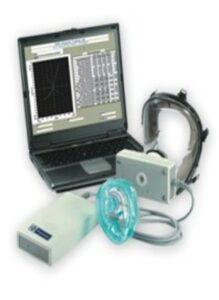Are you eager to explore the intriguing realm of Rhinomanometers? Prepare to embark on a journey of discovery as we unravel the secrets of this remarkable medical device. Rhinomanometers, with their cutting-edge technology, offer valuable insights into the intricate workings of the nasal passages and play a pivotal role in the diagnosis and management of nasal conditions.
Throughout our journey into the depths of Rhinomanometry, we will navigate through comprehensive instructions on utilizing this device with precision, deciphering its measurements, and unlocking the invaluable insights it offers. We will also delve into the exciting advancements in Rhinomanometer technology, offering a glimpse into the future of nasal diagnostics.
Everything You Need to Know About Rhinomanometers
Rhinomanometers are powerful medical devices that have revolutionized the field of rhinology. By virtue of their capacity to assess nasal airflow and pressure, Rhinomanometers assume a vital function in the diagnosis and ongoing evaluation of nasal conditions. Understanding the key features, benefits, and applications of Rhinomanometers is essential for healthcare professionals and patients alike.
One of the primary features of Rhinomanometers is their accuracy in assessing nasal airflow. By measuring the pressure and resistance within the nasal passages, these devices provide valuable insights into the function of the respiratory system. This information helps identify abnormalities, such as nasal obstructions or deviated septum, which may be contributing to symptoms like congestion or breathing difficulties.
Moreover, Rhinomanometers provide numerous advantages when it comes to the diagnosis and ongoing monitoring of nasal conditions. They provide quantitative data, allowing for precise measurements and objective assessments. They are instrumental in diagnosing conditions like allergic rhinitis, sinusitis, nasal polyps, and septal deviations. Rhinomanometers also aid in assessing treatment outcomes and optimizing patient management.
Types of Rhinomanometers
There are different types of rhinomanometers available, each designed to measure nasal airflow in specific ways. Here are some common types.
- Anterior Rhinomanometer: This type of rhinomanometer measures nasal airflow through the anterior (front) part of the nostrils. It usually involves the patient breathing in and out through one nostril while the other is closed off.
- Posterior Rhinomanometer: This type measures nasal airflow through the posterior (back) part of the nostrils. It may involve inserting a catheter or probe into the nostril to measure airflow resistance.
- Active Rhinomanometer: Active rhinomanometers use controlled airflow generated by a machine to measure nasal resistance. The patient breathes against the controlled airflow, and the resistance is measured.
- Passive Rhinomanometer: Passive rhinomanometers measure nasal resistance when the patient breathes naturally, without the use of controlled airflow.
- Acoustic Rhinomanometer: This type measures nasal airflow by analyzing sound produced during nasal breathing. It uses the principle that airflow through the nasal passages generates specific acoustic signals.
- Digital Rhinomanometer: Digital rhinomanometers use electronic sensors to measure nasal airflow and resistance. They often provide real-time data and can be more precise in their measurements.
- Manometric Rhinomanometer: Manometric rhinomanometers measure nasal resistance using pressure sensors. These sensors detect changes in pressure as the patient breathes through their nose.
- Intranasal Rhinomanometer: This type involves placing a probe or catheter directly inside the nasal passages to measure airflow and resistance.
- Portable Rhinomanometer: These devices are designed for portable and convenient use, often used in research studies or clinical settings where nasal patency needs to be assessed in different locations.
- Computerized Rhinomanometer: Computerized rhinomanometers are connected to a computer system, allowing for more comprehensive data analysis and storage of measurements over time.
It’s important to note that the choice of rhinomanometer depends on the specific diagnostic requirements and preferences of the medical professional or researcher. Each type has its advantages and limitations, and the appropriate type will be chosen based on the clinical context and the goals of the assessment.
Navigating Rhinomanometry with Ease:
Using a Rhinomanometer may initially appear challenging, but with the right technique and understanding, it becomes a straightforward process. Follow this comprehensive step-by-step process to ensure accurate nasal pressure measurements and enhance your proficiency in utilizing this vital medical instrument.
- Familiarize Yourself with the Rhinomanometer: Before diving into Rhinomanometer usage, take a moment to familiarize yourself with its components and functionality. Explore the pressure sensors, airflow tube, and control panel, gaining a comprehensive understanding of how the device operates.
- Prepare the Patient and Position the Rhinomanometer: Create a comfortable environment for the patient, ensuring they are seated in a relaxed position. Position the Rhinomanometer for easy access to the patient’s nasal passages, optimizing accuracy and minimizing discomfort.
- Calibrate the Rhinomanometer: To guarantee precise measurements, follow the manufacturer’s instructions for calibration. This crucial step involves zeroing the device or adjusting the pressure sensors, ensuring reliable readings.
- Insert the Nasal Probe: With gentleness and care, insert the nasal probe into the patient’s nostril. Ensure a secure and comfortable fit, allowing for accurate readings of nasal airflow and pressure.
- Initiate the Measurement: Begin the measurement process by following the instructions on the Rhinomanometer’s control panel. This typically involves pressing a designated button or selecting the appropriate setting to start data collection.
- Monitor the Readings: As the Rhinomanometer collects data, attentively monitor the readings displayed on the control panel. Focus on parameters such as nasal airflow, resistance, and pressure, as these measurements offer valuable insights into nasal function.
Document and Analyze the Results: Once the measurement is complete, record the obtained results for future reference. Thoroughly analyze the data, meticulously identifying any irregularities or patterns that may require additional investigation or consideration for treatment.
By following these step-by-step instructions, you can confidently utilize a Rhinomanometer to obtain accurate nasal pressure measurements. Remember, precision and attention to detail are essential for reliable results and your continued growth in utilizing this indispensable medical instrument.
Rhinomanometers for Nasal Allergy Testing
Nasal allergies can significantly impact daily life, causing discomfort and affecting overall well-being. Rhinomanometers play a crucial role in allergy testing, aiding in the diagnosis and management of nasal allergies.
- Identifying Allergen Triggers: Rhinomanometers help identify specific allergens that trigger nasal allergy symptoms. By measuring nasal airflow and pressure, these devices pinpoint the substances that provoke allergic reactions, enabling personalized treatment plans and avoidance strategies.
- Assessing Allergy Severity: Rhinomanometers provide data for assessing the severity of nasal allergies. Precise measurements of nasal airflow resistance help determine the degree of congestion and obstruction caused by allergies, guiding treatment decisions and monitoring effectiveness.
- Enhancing Allergy Testing: Rhinomanometers complement traditional allergy testing methods by providing objective data on nasal airflow and pressure. They contribute to a more comprehensive evaluation of nasal responses to allergens, leading to a more precise diagnosis.
- Tailoring Treatment Strategies: Rhinomanometer readings help healthcare professionals tailor treatment strategies to each patient’s nasal allergy profile. The data obtained guides the selection of appropriate medications, allergen immunotherapy, or other interventions to alleviate symptoms and improve nasal health.
By incorporating Rhinomanometers into allergy testing, healthcare professionals can enhance the accuracy of diagnoses, personalize treatment plans, and improve patient outcomes.
Applications of Rhinomanometers
Nasal obstruction, causing difficulty in breathing through the nose, significantly impacts the quality of life. Rhinomanometry plays a vital role in assessing airflow resistance, aiding treatment optimization. Explore its applications:
- Precise Airflow Resistance Measurement: Rhinomanometry quantifies nasal airflow resistance accurately. It identifies obstructions caused by anatomical abnormalities or inflammation, providing objective data.
- Severity Identification: Measuring airflow resistance within the nasal passages helps determine the severity of obstruction. Healthcare professionals assess blockage impact and tailor treatment accordingly.
- Treatment Optimization: Rhinomanometry data optimize treatment strategies for nasal obstruction. It evaluates interventions’ effectiveness and guides adjustments for improved nasal airflow.
Understanding Rhinomanometry’s significance in nasal obstruction assessment empowers targeted treatment plans and enhances patient care. Objective measurements enable better evaluation, identification, and improved respiratory well-being.
Future Horizons: Advancements in Rhinomanometer Technology
As medical technology continues to evolve, the future of Rhinomanometer technology holds immense promise for revolutionizing nasal diagnostics. Ongoing research and innovative developments are poised to transform the way we assess and manage nasal conditions.
Advanced sensor technologies and digital interfaces are being integrated into Rhinomanometers, allowing for more precise and convenient measurements of nasal airflow and pressure. Furthermore, the integration of artificial intelligence and machine learning algorithms with Rhinomanometry data opens up new possibilities for data analysis and interpretation. These intelligent systems can assist in identifying patterns, predicting outcomes, and providing personalized treatment recommendations.
In the future, Rhinomanometers may also incorporate telemedicine capabilities, enabling remote monitoring and consultation for patients. By staying informed about the advancements in Rhinomanometer technology, healthcare professionals can remain at the forefront of nasal diagnostics, providing patients with the most cutting-edge and effective care possible.
Medzell: Pioneering Transformation in the Medical Device Industry
Enter Medzell, an innovative B2B platform on a mission to revolutionize the medical device industry, particularly in emerging markets. This visionary platform serves as a game-changer, connecting medical device manufacturers, suppliers, and healthcare professionals, and facilitating the seamless exchange of cutting-edge medical technologies.
Within Medzell’s comprehensive marketplace, a wide array of medical devices, including Rhinomanometers, takes center stage. These essential tools for diagnosing and monitoring nasal conditions are readily available through Medzell’s partnerships with trusted manufacturers, ensuring uncompromising quality and performance.
Rhinomanometers From Leading Indian Manufacturers
Rhinocare
 Recorders & Medicare Systems Pvt Ltd, a renowned manufacturer, exporter, and supplier in the medical industry, proudly presents Rhinocare. With Rhinocare, medical professionals can revolutionize their diagnostic capabilities and enhance patient care.
Recorders & Medicare Systems Pvt Ltd, a renowned manufacturer, exporter, and supplier in the medical industry, proudly presents Rhinocare. With Rhinocare, medical professionals can revolutionize their diagnostic capabilities and enhance patient care.
One of the standout features of Rhinocare is its ability to provide clear and precise sigmoid and sinusoidal graphics. This advanced visualization allows for a comprehensive analysis of nasal airflow patterns, aiding in the accurate assessment of respiratory function. Whether evaluating pre- or post-vasoconstriction scenarios, Rhinocare enables efficient before-and-after comparisons, enabling clinicians to monitor treatment effectiveness and progress.
The device’s automatic selection of respiratory cycles further simplifies the diagnostic process, ensuring optimal data collection. This intelligent functionality eliminates the need for manual intervention, saving valuable time and enhancing workflow efficiency. Additionally, Rhinocare’s auto-calculation and display of nasal resistances provide valuable insights into nasal health, allowing healthcare professionals to evaluate nasal obstruction and monitor treatment outcomes effectively.
Conclusion
Rhinomanometers have emerged as indispensable tools in the field of rhinology, offering invaluable insights into nasal health and function. Through their precise measurements and data analysis, these devices aid in diagnosing and monitoring various nasal conditions, contributing to enhanced patient care and treatment outcomes.
As we have explored in this in-depth exploration, Rhinomanometers provide healthcare professionals with a window into the intricate workings of the nasal passages. By understanding the key features, benefits, and applications of Rhinomanometers, medical practitioners can make informed decisions regarding their usage in diagnosing and managing nasal conditions.


